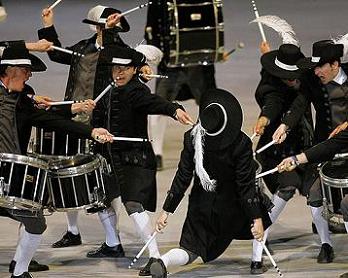
 : : Great drummers
: : Great drummers
- Acuña Alex
- Agostini Dante
- Alexander Tim "Herb"
- Allen Tony
- Ameen Robby
- Appice Carmine
- Aronoff Kenny
- Arpino Thierry
- Barretto Ray
- Belleville Pierre
- Bellson Louie
- Bissonette Gregg
- Blackwell Ed
- Blaine Hal
- Blakey Art
- Bonham John
- Bozzio Terry
- Brown Carlinhos
- Brown Gerry
- Bruford Bill
- Carrington Terri Lyne
- Ceccarelli André
- Cerrone Marc
- Chambers Dennis
- Cinelu Mino
- Clarke Kenny
- Cobham Billy
- Colaiuta Vinnie
- Collins Phil
- Conte Luis
- Copeland Stewart
- Da Fonseca Duduka
- de Grasso Jimmy
- de Johnette Jack
- Diabaté Inza
- Diaz Miguel "Anga"
- Dodds Warren "Baby"
- Donati Virgil
- Dunbar Lowell “Sly”
- Erbetta Marc
- Erskine Peter
- Escovedo Sheila "E"
- Ewandé Louis César
- Fanfant Jean-Philippe
- Foster Al
- Gadd Steve
- Garibaldi David
- Gastaldin Claude
- Gonzalez Jerry
- Gozzo Alain
- Greer Sonny
- Grohl Dave
- Guem
- Gurtu Trilok
- Gustke Ralf
- Hakim Omar
- Haynes Roy
- Hernandez “El Negro” Horacio
- Hidalgo Giovanni
- Higgins Billy
- Hoglan Gene
- Humair Daniel
- Hussain Zakir
- Jacquin Jean-Christophe
- Jimbo Akira
- Jones Elvin
- Jones "Philly" Joe
- Jones « Papa » Jo
- Jordison Joey
- Katché Manu
- Keita Mamady
- Kolinka Richard
- Krupa Gene
- Lake JR Oliver Gene
- Lang Thomas
- Latham Rick
- Mac Brain Nicko
- Mason Harvey
- Mattalia Alessia
- Mayer Jojo
- Michelino Silvano
- Minnemann Marco
- Mitchell John "Mitch"
- Mocidade Independente de Padre Miguel
- Moeller Sanford
- Moreira Airto
- Morello Joe
- N'Diaye Rose Doudou
- Oxley Tony
- Paice Ian
- Paolini Jean-Claude
- Parker Leon
- Peart Neil
- Phillips Simon
- Poleo Orlando
- Porcaro Jeff
- Portnoy Mike
- Pozo Chano
- Priester Aquiles
- Puente Ernesto « Tito »
- Purdie Bernard "Pretty"
- Quintana Jose Luis "Changuito"
- Rekow Raul
- Renaudin Bertrand
- Rich Buddy
- Roach Max
- Roddy Derek
- Samba Mokhtar
- Sanchez Poncho
- Santamaria Mongo
- Séry Paco
- Smith Chad
- Smith Marvin “Smitty”
- Smith Steve
- Sorum Matt
- Starr Ringo
- Stewart Bill
- Stubblefield Clyde
- Temiz Okay
- Terrana Mike
- Top Secret Drum Corps Basel Suisse
- Ulrich Lars
- Vander Christian
- Wassy Brice
- Watts Charlie
- Watts Jeff
- Webb Chick
- Weckl Dave
- White Lenny
- Wilk Brad
- Williams Tony
- Ziad Karim
Top Secret Drum Corps Basel Suisse
Musicians or bands:
Biography and commentary:

Top Secret is a military drum parade band that combines creativity and European tradition with breathtaking virtuosity (juggling (with sticks and flags), choreography (theater, costumes), alternated playing between musicians (including several bass drums melodically tuned and played with two mallets) passages on neighbors drums, funky compositions, Brazilian, etc.). The Swiss are known for their use of the drum in the army (to pace the “march” (“walk” in French) of battalions of pikemen and halberdiers), since the fifteenth century, the first in Europe. Following the battle of Marignan (1515) Swiss battalions with their drums, were integrated into the French army, which later developed specific rudiments and compositions (called "the French school of drum," each country having its own, to distinguish them by ear on the battlefield, keep the ordering codes secret and perhaps also by competitive spirit), which the peak coincides with the time of the "Grande Armée" (“Great army”) of Napoleon Bonaparte ("Batteries du premier Empire": “First Empire military drumming compositions”). Consisting of an army of commoners mercenaries (or "soldiers") which served almost all European countries, the Swiss inspired as well rapidly German mercenaries (the "Landsknechte" ("peasants servants"), "lansquenets" in French). The drum also optimised the use of the single shot rifle by the order then resulting. Even for the suit (not so far from that of the “mousquetaires du Roi” ("musketeers of the King")), this use prefigured modern armies (from the sixteenth to the nineteenth century), professional, and the return of the infantry on the front of the military scene, while the middle ages was marked by the supremacy of the horsemen in armor of the aristocracy (the "Chivalry"), superseded by firearms (volley of bullets paced in rows, piercing the armors). With "Top Secret", the military drumming shows it has not said its last word and exhausted its creative potential, while drawing from the oldest tradition.
Marc De Douvan, publication in French: November 22, 2006 (for the translation in English: July 12, 2015)
Official website
SeeLink to Drummerworld or other
See© 2005 Marc de Douvan Crédits Mentions légales
